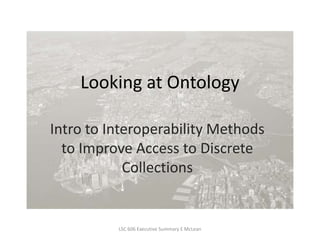Ontology: Intro to Interoperability Methods to Improve Access to Collections
- 1. Looking at OntologyIntro to Interoperability Methods to Improve Access to Discrete CollectionsLSC 606 Executive Summary E McLean
- 2. Current ConditionsLSC 606 Executive Summary E McLean
- 3. Current Conditions: FoggyTaxonomiesSocial taggingNatural language processingThesauriControlled vocabulariesClassificationSemantic webRDFDCMIKOS/SKOSOntologyOWL¡..STOP!!!LSC 606 Executive Summary E McLean
- 4. Concepts, Comparisons and UsBig Picture: Library and Information Centers rope in knowledge or artifact collection attributes with diverse tools and standards in order to:Organize the information,
- 5. Provide bibliographic description,¡.and improve access LSC 606 Executive Summary E McLean
- 6. Concepts, Comparisons and UsBig Picture: Library and Information Centers rope in knowledge or artifact collection attributes with diverse tools and standards using:LSC 606 Executive Summary E McLean
- 7. Concepts, Comparisons and UsBig Picture: Library and Information Centers rope in knowledge or artifact collection attributes with diverse tools and can use Ontologies to incorporate both Access and Description functions at once for web/data environments:OntologyLSC 606 Executive Summary E McLean
- 8. Controlled Vocabulary or Ontology?LSC 606 Executive Summary E McLean
- 9. Which brings us to..W3C Semantic Web¡°Web of data¡± ¨COntology as processing tool interconnecting stand alone data sets Illumination Collection StudyVocabulary interoperability studyWolfram-Alpha Computational knowledge engine that draws on multiple sources to answer user queries directly. http://www.wolframalpha.com/screencast/introducingwolframalpha.htmlLSC 606 Executive Summary E McLean
- 10. Use Studies LSC 606 Executive Summary E McLean
- 11. "Semantic" interoperability is based on a precise and correct use of the formal RDF semantics embodied in the RDF graph data model and in RDF-based vocabularies such as DCMI Metadata Terms. Semantics¡refers to formally stated relationships between terms and rules for using such statements to draw automatic conclusions (logical inference)s¡±.Dublin core metadata initiativeLSC 606 Executive Summary E McLean
Editor's Notes
- #3: Sub this image for one without the rope bridgeInformation and data collections professionals are working to establish interoperability among previously heterogeneous collections or bodies of knowledge (or data or metadata or objects) by interlinking them on the web. Say again? Ex: Cross-institutional scales are becoming more viable than single holding institutions (ex: WRLC, WDL)Because we have such an uncontrollable flow of information on the Web, this dictates the need to capture and organize in the most meaningful way for user retrieval (improved access) based on conceptual relationships established by LIS and other information professionals. Establishing interoperability between heterogeneous collections is becoming more and more complex. (ex Illumination Collections study ¨C foreign language, diff standards applied, The context used to organize a collection of knowledge (antelopes, etc.) may be different in any number of characteristics - metadata schemes, thesauri, definitions, language, encoding standardsBecause our information needs are now becoming more interdisciplinary and complex in nature, digital metadata standards and classifications alone are not bridging the gaps that users experience when searching collections that are not physically or organically linked but would have important, specific meaning for the user if linked together. Meaning is context, context brings out new meaning. ?Example: Bioinformatics field ¨C fusion of subjects like biology, genetics, DNA and computer scienceMeaning ¨C WHAT is WHAT? About meanings - = term ¡°Semantic¡±As Information organizers, our field is studying how to improve access to silo¡¯d areas of knowledge that, when brought together for given query context, will return complex, precise and meaningful result sets.Ontology becomes a tool = collection of concepts arranged in a hierarchy of categories (Gokhale, 2009)
- #4: Here are some terms that you will encounter when you dip your toes into this pool¡.My point ¨C let¡¯s step back and understand what the user benefits are to the myriad of organization methods
- #7: Created by using special ontology software applications and provides a way to define a set of elements where: concepts and terms in a knowledge area can be represented
- #9: Existing examples of these studies at work todayWithout Ontology, there can¡¯t be interoperability (right now)Single point of access for userContext and concept based
- #10: Check out the use studies underway and the tools each are utilizing to become more familiar with real world application development and how the components of semantic web are used.
- #11: May not use this slide ¨C brings us back to current day standards and where they fit in to tomorrow.










